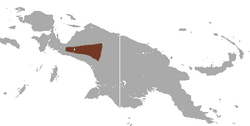Biology:Weyland ringtail possum: Difference between revisions
From HandWiki
Wikisleeper (talk | contribs) (simplify) |
(correction) |
||
| Line 2: | Line 2: | ||
{{Speciesbox | {{Speciesbox | ||
| name = Weyland ringtail possum<ref name=msw3>{{MSW3 Groves | pages = 52}}</ref> | | name = Weyland ringtail possum<ref name=msw3>{{MSW3 Groves | pages = 52}}</ref> | ||
| image = | | image = 1921.8.1.15 Skin Dorsal Skins-3 MG 1905-S.jpg | ||
| status = LC | | status = LC | ||
| status_system = IUCN3.1 | | status_system = IUCN3.1 | ||
| Line 8: | Line 8: | ||
| genus = Pseudochirulus | | genus = Pseudochirulus | ||
| species = caroli | | species = caroli | ||
| authority = Thomas, 1921 | | authority = (Thomas, 1921) | ||
| synonyms = | | synonyms = | ||
| range_map = Weyland Ringtail Possum area.png | | range_map = Weyland Ringtail Possum area.png | ||
| Line 14: | Line 14: | ||
}} | }} | ||
The '''Weyland ringtail possum''' ('''''Pseudochirulus caroli''''') is a species of [[Biology:Marsupial|marsupial]] in the family [[Biology:Pseudocheiridae|Pseudocheiridae]]. It is endemic to the western [[Place:New Guinea Highlands|Central Cordillera]] of Papua Province, Indonesia.<ref name="iucn status 11 November 2021" /> ''P. | The '''Weyland ringtail possum''' ('''''Pseudochirulus caroli''''') is a species of [[Biology:Marsupial|marsupial]] in the family [[Biology:Pseudocheiridae|Pseudocheiridae]]. It is endemic to the western [[Place:New Guinea Highlands|Central Cordillera]], including the Weyland and Star Mountains, of Papua Province, Indonesia.<ref name="iucn status 11 November 2021" /> ''P. caroli'' is also "known from four localities west of the Star Mountains" and tends to live in montane forest or other hilly areas.<ref name="iucn status 11 November 2021" /> Currently, the Weyland ringtail is not endangered but should be "monitored [because] it could rapidly become threatened if either human encroachment or hunting were to increase significantly."<ref name=Helgen,Leary,Singadan,Menzies,Wright2008>{{cite iucn |author=Helgen, K. |author2=Leary, T. |author3=Singadan, R. |author4=Menzies, J. |author5=Wright, D. |date=2016 |title=''Pseudochirulus caroli'' |volume=2016 |page=e.T18507A21961944 |doi=10.2305/IUCN.UK.2016-2.RLTS.T18507A21961944.en |access-date=16 November 2021}}</ref> | ||
==References== | ==References== | ||
{{Reflist}} | {{Reflist}} | ||
{{Diprotodontia|P.1}} | |||
{{Taxonbar|from=Q209571}} | {{Taxonbar|from=Q209571}} | ||
Latest revision as of 02:22, 10 June 2025
Short description: Species of marsupial
| Weyland ringtail possum[1] | |
|---|---|

| |
| Scientific classification Error creating thumbnail: Unable to save thumbnail to destination
| |
| Domain: | Eukaryota |
| Kingdom: | Animalia |
| Phylum: | Chordata |
| Class: | Mammalia |
| Infraclass: | Marsupialia |
| Order: | Diprotodontia |
| Family: | Pseudocheiridae |
| Genus: | Pseudochirulus |
| Species: | P. caroli
|
| Binomial name | |
| Pseudochirulus caroli (Thomas, 1921)
| |

| |
| Weyland ringtail possum range | |
The Weyland ringtail possum (Pseudochirulus caroli) is a species of marsupial in the family Pseudocheiridae. It is endemic to the western Central Cordillera, including the Weyland and Star Mountains, of Papua Province, Indonesia.[2] P. caroli is also "known from four localities west of the Star Mountains" and tends to live in montane forest or other hilly areas.[2] Currently, the Weyland ringtail is not endangered but should be "monitored [because] it could rapidly become threatened if either human encroachment or hunting were to increase significantly."[3]
References
- ↑ Groves, C.P. (2005). Wilson, D.E.; Reeder, D.M.. eds. Mammal Species of the World: A Taxonomic and Geographic Reference (3rd ed.). Baltimore: Johns Hopkins University Press. p. 52. ISBN 0-801-88221-4. OCLC 62265494. http://www.departments.bucknell.edu/biology/resources/msw3/browse.asp.
- ↑ 2.0 2.1 2.2 Helgen, K.; Leary, T.; Singadan, R.; Menzies, J.; Wright, D. (2016). "Pseudochirulus caroli". IUCN Red List of Threatened Species 2016: e.T18507A21961944. doi:10.2305/IUCN.UK.2016-2.RLTS.T18507A21961944.en. https://www.iucnredlist.org/species/18507/21961944. Retrieved 11 November 2021.
- ↑ Helgen, K.; Leary, T.; Singadan, R.; Menzies, J.; Wright, D. (2016). "Pseudochirulus caroli". IUCN Red List of Threatened Species 2016: e.T18507A21961944. doi:10.2305/IUCN.UK.2016-2.RLTS.T18507A21961944.en. https://www.iucnredlist.org/species/18507/21961944. Retrieved 16 November 2021.
Template:Diprotodontia Wikidata ☰ Q209571 entry
 |


